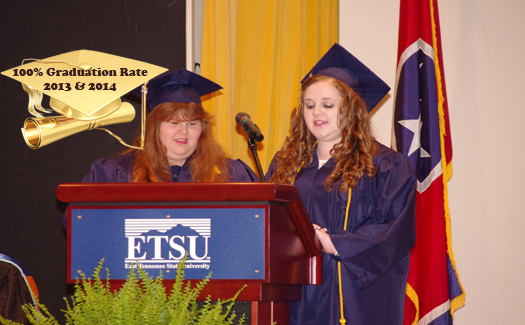100% Graduation Rate
Most local high schools ahead of 90-percent graduation rate goal
May 26th, 2015 9:45 pm by Tony Casey
 A high school's overall graduation rate is a single number, but area high school principals
and school system administrators say many factors go into that rate.
A high school's overall graduation rate is a single number, but area high school principals
and school system administrators say many factors go into that rate.
The federal government has set the bar at 90 percent for school systems, and many in Tennessee are hitting that mark — the state average is 86.3 percent, higher than the national average of 80 percent.
Topping the local list for 2013 and 2014 was University High School, a Washington County School District facility on the East Tennessee State University campus. UHS earned an "A" on any grading scale by achieving a 100-percent graduation rate both years, including the same mark for those deemed "economically disadvantaged."
2015 school year figures don't become available from the Tennessee Department of Education until the end of the year.
Another UHS — Carter County's Unaka High School —l found itself near the bottom of the state with a 67.5 percent graduation mark in 2014, down 16 points from 2013. That includes a 31.2 percent chance of someone with disabilities graduating from Unaka High School.
Jerri Beth Nave, the system's director of federal programs and testing, didn't get specific on any of the Carter County schools, but said their ability to get students to graduate is greatly increased when they can get their graduation coaches to the at-risk students earlier rather than later in high school.
"When they get behind, there's a greater chance of them dropping out," Nave said. "But we do whatever it takes to get them to graduation."
Nearby Elizabethton High School increased its graduation rate from 93.9 percent to 96.6 percent over the course of the same year.
Washington County's Daniel Boone and David Crockett high schools both saw graduation rate increases, with Boone moving from 90.4 percent in 2013 to 91.3, and Crockett from 88.3 to 88.9 percent.
These numbers, said William Flanary, Director of Secondary Education with Washington County Schools is happy to see the numbers continue to rise, but says they are extremely flexible depending on the students in each graduating class.
"We shoot for 100 percent, obviously, but a certain percentage are those who don't live in the area anymore and we can't document that they're enrolled somewhere else," Flanary said. "We do a lot of foreign exchange students, Europe and Asia, and they are put on as a potential graduate. The state department counts them even though they go home."
These all keep the system's figures lower than they could be.
That being said, he said the educational system is set up to work each and every student in the system through their classes and requirements, earning them a chance to walk across the stage to earn their diploma, but a small percentage needs some extra help.
"We're only talking about a small percentage of students who need that extra help," he said.
For those students, there is everything from graduation coaches and tutoring available before, during and after school hours, as well help to get students their high school diploma, even if it requires the school working with them past their spring graduation and into the fall.
These graduation rates are important to educators because of the close ties their diploma has to the students' futures.
"Students who drop out of high school are disproportionately more likely to be unemployed, more likely to be in prison, more likely to be on welfare, have higher health care costs and, sadly, to go on to have children who also end up dropping out from high school," John Bridgeland, CEO of Civic Enterprises, which puts out the Building a Grad Nation, said, according to Tennessee Public News Service.
Other area school figures have Greeneville High School graduating 98.6 percent of students, up from 96.7 the year before; Unicoi County High School graduating 93.6 in 2014, down from 94.9 in the previous year, and Johnson County High School seeing 98.6 percent of its students graduate high school, up from the 97.7 percent figure the year before.
For Johnson City Schools, its biggest high school, Science Hill, saw a slight decrease from 2013 to 2014, with the rate falling from 91.7 to 90.4, though the graduation rate for those educationally disadvantaged jumped from 74.7 to 83.3 percent.
The school's principal, Melanie Riden-Bacon, like Flanary in Washington County, said those numbers fluctuate in a big way depending on the cohorts measured by state. It's important to point out that the students in any given graduating class don't necessarily match up with the yearly figures.
Many accounted for in the numbers, the Science Hill principal said, are never seen or heard from again and count against the school as a dropout. This is mostly because of the lack of proper documentation to show that they continued their education in another school.
But that doesn't mean she isn't trying to get that information: she and her team has been successful tracking down the documents of former students, whose ultimate result will affect the way the school is graded.
Riden-Bacon said that of the 561 students who graduated in 2014, only 13 are going to summer school and she her fellow educators will do everything they can to reach their collective goal of receiving that diploma. It's the ones she doesn't have access to, the ones who left and there's no indication where they are now, that she said is frustrating to her.
"We try to make sure we've done everything we can to get them to graduate," she said.
© 2015 Johnson City Press